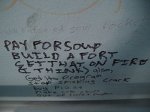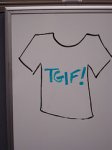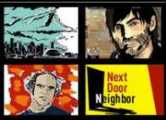Go to the photos



“Maybe you’re walking around the festival and a gaggle of motorized cupcakes whizzes past, while a troupe of French maids is trying, ineffectually, to tidy up the desert with feather dusters, all in the shadow of a barn-sized rubber duck with a jazz club in its belly. Then things will probably get weirder.”
On the eve of her book tour, and just weeks before the 2007 Burning Man festival (this year’s theme: green), SMITH’s Kathy Ritchie talked to Jessica Bruder, a 29-year-old staff writer for The Oregonian and author of Burning Book: A Visual History of Burning Man.
MORE ON BURNING MAN
SMITH: Tell us your favorite Burning Man story.
Jessica Bruder: The wildest Burning Man story is the event’s own history. Two guys torched a hastily assembled, eight-foot-tall wooden effigy on a San Francisco beach in 1986… and ka-boom! That impulsive gesture exploded into the center of an enormous celebratory metropolis built each summer by tens of thousands of people–more than 39,000 folks in 2006.
Win this book!
 Send SMITH your Burning Man story in 100 to 1000 words. Five storytellers will win a copy of Jessica Bruder’s brilliant and beautiful Burning Book.
Send SMITH your Burning Man story in 100 to 1000 words. Five storytellers will win a copy of Jessica Bruder’s brilliant and beautiful Burning Book.
But my favorite Burning Man story is a quieter one.
It began in 1998, when an Oregon fisherman showed up in the desert with 1,300 pounds of tuna loins. That was a bad year for fishermen in the Pacific Northwest; a global glut made tuna all but worthless. So 63-year-old “Cap’n” Jim Peterson from Coos Bay packed his entire catch in a U-Haul with ice and drove it out to Nevada. He figured he’d sell it to the revelers at Burning Man.
Jim had seen some pictures from the festival the year before. These were wild scenes, folks slathered from head to toe in mud, cavorting gleefully as if they’d never been in the middle of such a delightful mess. He figured all that running around must work up an appetite. Even mud-people have to eat. Maybe they would buy his tuna?
Jim drove 450 miles to Burning Man, only to learn that vending is against the rules there (and bad etiquette, too). So he started a marathon barbecue session. He served his tuna to everyone in sight. He ended up giving it all away.
Now, every year at Burning Man, Jim and his friends—nicknamed “The Tuna Guys”—bring hundreds of pounds of fish to cook and share with everyone. And it’s not easy for them; they’ve had their share of misadventures. Their rattletrap pickups and Volkswagens always seem to break down on the long drive to the festival. And the Nevada health department has hounded them so much, their camp has practically become a seafood speakeasy.
I love his story, because it offers insight about the kind of dedication and generosity the festival seems to bring out in some people. These days, the mere mention of Burning Man conjures up visions of tech-savvy hipsters baying at the moon and gyrating around the desert in hot pink fake-fur loincloths. That stuff bores me. And that’s why I love the Tuna Guys’ story—it’s less about the Burning Man stereotype, more about the potluck style of participation that makes the event so fascinating.
What can Burning Man newbies expect?
 Expect sensory bombardment. Just when you’ve decided the scene is strange—maybe you’re walking around the festival and a gaggle of motorized cupcakes whizzes past, while a troupe of French maids is trying, ineffectually, to tidy up the desert with feather dusters, all in the shadow of a barn-sized rubber duck with a jazz club in its belly. Then things will probably get weirder.
Expect sensory bombardment. Just when you’ve decided the scene is strange—maybe you’re walking around the festival and a gaggle of motorized cupcakes whizzes past, while a troupe of French maids is trying, ineffectually, to tidy up the desert with feather dusters, all in the shadow of a barn-sized rubber duck with a jazz club in its belly. Then things will probably get weirder.
Remember and repeat: you can’t see everything at Burning Man. Finding a specific niche during the event is a great way to get your bearings. Black Rock City—the name of Burning Man’s temporary metropolis—can feel amorphous and alienating to first-timers. But if you’re hammering nails on an art installation, greeting people at the front gate, DJ’ing at a local low-wattage radio station, or lending your hands to any one of hundreds of projects, that’s a great way to feel like you’re a part of things and get oriented.
And don’t forget to drink water. Plenty of water.
Best way to attend Burning Man: Naked or clothed—and why?
In my personal opinion? Clothed. Particularly if you’re as pale as I am, which means the desert sun will leave you about as comfortable and attractive as a well-boiled lobster.
I don’t have a problem with most of the naked people at Burning Man. For some of them, I think going naked probably feels like wearing any other kind of costume (apart from the ventilation factor).
Only one kind of nudity makes my eyes bleed: men wearing T-shirts and no pants. Those guys look awful. They’re prime targets for one of my favorite Burning Man inventions: the pants cannon, which uses air pressure to sling slacks over great distances. I consider the pants cannon a public service.
How has the story of Burning Man changed from the first year you went to the last year?
For the better part of two decades, the festival’s survival from one year to the next was precarious. But in 2006, the federal Bureau of Land Management—essentially Burning Man’s landlord—granted the event a five-year permit to operate in the Black Rock Desert.
Now people are wondering just how far the game can go. They’re debating whether Burning Man should be a self-contained escape from routine, or if festival-goers share enough common desires and values to work together towards some kind of progress—social, political, environmental—during the rest of the year.
After Hurricane Katrina struck in 2005, a group of festival-goers (later named “Burners Without Borders”) went down to Mississippi to help clean up. They found some of their desert skills—building a base camp in a hostile environment, working with heavy machinery on colossal, daunting projects—came in handy as they rebuilt a devastated Buddhist monastery and demolished 60 ruined houses.
Now that Burning Man has proved it’s not a passing fancy, how does the whole thing evolve? That’s where the narrative tension is today. People weren’t thinking in quite those terms back in 2002, when I started attending the festival.
On top of that, the event keeps growing. In 2002, the population hit about 29,000 people; there were more than 39,000 people at Burning Man in 2006.
If the Burning Man festival itself had a six-word memoir, what might it be?
Dusty wide kaleidoscope, where’s my chapstick?
And your own personal six-word memoir?
Talk to me. Write it. Repeat.
Click on photos to enlarge; mouseover for previous and next.





























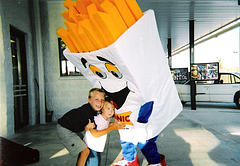 Ah, it’s Labor Day weekend and you know what that means: three-day weekend and BBQ time! My, how times have changed since the holiday was first observed way back in 1882. The good ol’ days.
Ah, it’s Labor Day weekend and you know what that means: three-day weekend and BBQ time! My, how times have changed since the holiday was first observed way back in 1882. The good ol’ days. 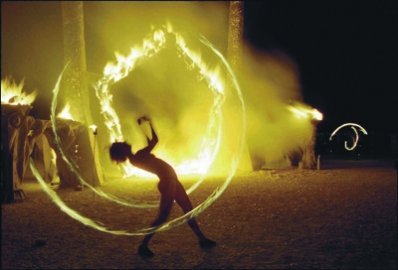
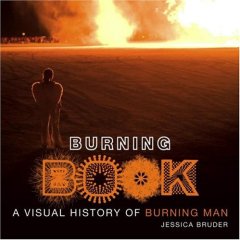 Wild stuff. Now it’s your turn. Got some drama in the desert to share? We want to hear it. Tell us your favorite Burning Man story in 100-1,000 words, and five burning storytellers will win a copy of
Wild stuff. Now it’s your turn. Got some drama in the desert to share? We want to hear it. Tell us your favorite Burning Man story in 100-1,000 words, and five burning storytellers will win a copy of 


 Send
Send  Expect sensory bombardment. Just when you’ve decided the scene is strange—maybe you’re walking around the festival and a gaggle of motorized cupcakes whizzes past, while a troupe of French maids is trying, ineffectually, to tidy up the desert with feather dusters, all in the shadow of a barn-sized rubber duck with a jazz club in its belly. Then things will probably get weirder.
Expect sensory bombardment. Just when you’ve decided the scene is strange—maybe you’re walking around the festival and a gaggle of motorized cupcakes whizzes past, while a troupe of French maids is trying, ineffectually, to tidy up the desert with feather dusters, all in the shadow of a barn-sized rubber duck with a jazz club in its belly. Then things will probably get weirder.




























